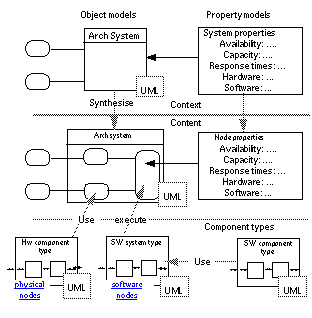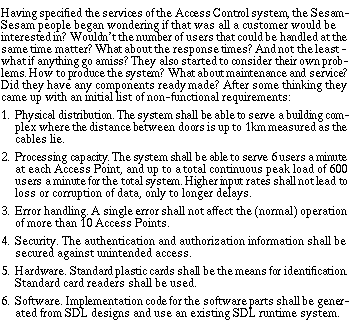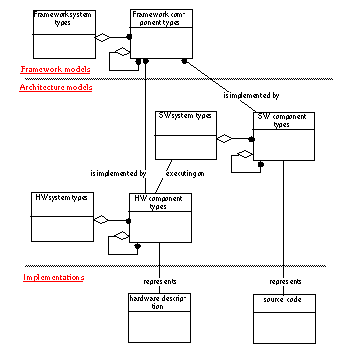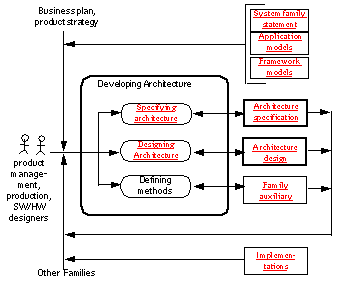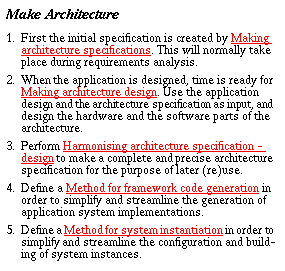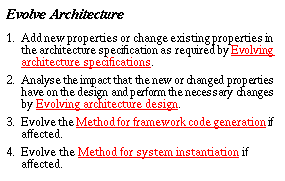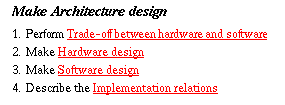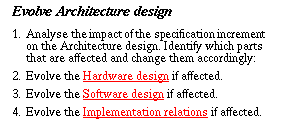Architecture

Content and scope
An architecture is an abstraction of a concrete system representing:
- the overall structure of hardware identifying at least all physical nodes and interconnections needed to implement an abstract system;
- the overall structure of software identifying at least all software nodes, software communications and relations needed to implement an abstract system (in terms of processes, procedures and data).
In this chapter we shall describe:
- Architecture reference model: the system model assumed in the architecture.
- Architecture models: how to describe architectures.
- Developing architecture: how to develop architecture models.
Architecture models are important because:
- they help to design the physical implementation in the first place;
- they serve to document how the system is implemented.
Documentation
Together the application, the framework and the architecture complement each other to form a complete documentation.
In the system reference models we distinguish between abstract systems and concrete systems as illustrated in Figure 53.
- Figure 53: Reference models for abstract and concrete system
- Open figure
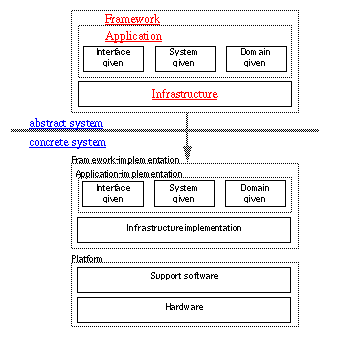
The architecture is a simplified model of the concrete system. Concrete systems are composed from real hardware and executable software that provide services to real users.
While abstract systems, described in application and framework models, are composed from abstract components, concrete systems are composed from physical components and software. It is the concrete system that really matters to the users, but it is the abstract systems that enable us to understand what it does and to ensure that its functionality has the desired quality.
As illustrated in Figure 53, concrete systems consist of:
-
Framework implementations. Here we find implementations of the abstract systems in hardware and software:
the application implementations.
the infrastructure implementation.
-
The Platform, which consists of:
the support software, which normally is a layered structure containing operating systems, middelware for distribution support, runtime systems for the languages used (SDL), DBMS and interface support;
the platform hardware, which typically is an network of computers.
For every new system development, the platform is an important design issue, as it determines important properties such as cost, reliability and flexibility. It also influences the way that applications and frameworks are implemented.
What
The architecture is an abstraction of the concrete system that emphasises high level hardware structure and software structure. It will not go into the implementation details but focus on the implementation principles and how functional and non-functional properties are satisfied. It will often be distributed and have additional support for internal communication, as illustrated in Figure 54.
- Figure 54: Architecture reference model
- Open figure
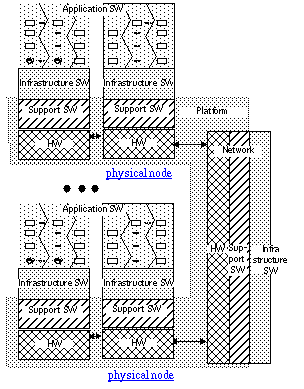
Objectives
By identifying key architectural elements, the reference model helps to structure architecture models and to guide their development. Although the model in Figure 54 is quite coarsely grained, it identifies elements that come from different domains where the driving forces behind change and evolution are quite different. Application evolution, for instance, may be due to new service requirements (market pull), while the reason for platform changes may be performance and price (technology push). Keeping such parts separate and as independent as possible, we believe, is a key to flexibility and profitability.
The architecture reference model contains the following main parts:
-
Hardware. It contains the underlying structure of
physical nodes and interconnections that may be classifies as:
General platform hardware. This is hardware that is not application framework specific. It will typically consist of general purpose computers in a network.
Application framework specific hardware. This is hardware needed for the particular application or infrastructure that the system implements. Here we find peripheral equipment, such as the panels in the AccessControl system, and other special purpose hardware.
- Support software, which contains such elements as:
the operating system;
middleware (e.g. CORBA) that supports distribution;
support for application framework programming, for instance: user interface tools (GUI), database management tools (DBMS), language runtime support (for SDL);
support for application framework input/output (I/O) (that is for interaction with hardware).
- Infrastructure software, which implements the necessary interface between the application and the support software.
- Application framework software. This is the software part of the framework implementation. It contains implementations of the:
- The application framework software can be further classified as:
automatically generated code;
manually generated code (handmade code).
- Foreign code, code that is imported from other sources, legacy code, etc.
In real-time systems a central software design issue is how to handle concurrency, timing and communication. To this end it is important that the architecture manages to model the organisation of concurrent software processes (also called tasks in some operating systems), how they communicate and how they are scheduled.
Other important issues are:
- the practical organisation in software modules that can be developed by separate teams;
- how to generate framework implementations;
- how to configurate and build concrete (executable) systems.
Generality
In the family area, architectures are supposed to be quite general and contain the variability needed in different system instances. As a minimum they must support the variability needed in applications.
It is generally a good idea to use the same basic principle we used to make frameworks from applications: to define a layered framework structure.
Applied to the hardware part, the architecture may be seen as a hardware framework made up by some (stable) general hardware and some (redefinable) application framework hardware.
In the software part, we find the basic operating system at the bottom, with the other parts as successive applications on top of that. We may organise this as several software frameworks on top of each other. Ideally the result is a high level software framework where all we need to do to generate a particular application is to supply the application specific code.
Differences between abstract and concrete system
A good designer must be well aware of the differences between the concrete and the abstract world. There are two main categories of such differences:
- Fundamental differences in the nature of components. Physical components are rather imperfect compared to the more ideal components of abstract systems. They develop errors over time, they are subject to noise, and they need time to perform their processing tasks.
- Accidental differences in the functioning of components. In both worlds there are concepts for concurrency, communication, sequential behaviour and data, but they are not necessarily the same.
The fundamental differences are related to: Processing time, Errors and noise, Physical distribution and Finite resources.
An abstract system is not limited by processing resources. Consequently the balance between the traffic load offered to the system and its processing capacity need not be considered. One simply assumes that the system is fast enough to process the load it is offered.
The real world is vastly different on this point. Each signal transfer, and each transition of a process, will take some time and require some processing resources. Due to these differences, the focal point of implementation design is quite different from that of the functional specification. The challenge is to find implementations for the abstract (SDL) concepts that are sufficiently fast to meet the traffic load and response time requirements without destroying the validity of the abstract system models.
One major issue is to balance the processing capacity of the implementation against the offered traffic load.
In the AccessControl system, for instance, the average peak load is 600 validations a minute. This means that a central computer must process each validation in less than one tenth of a second. How much less will depend on the other tasks the computer has to do and the margin one wants against overloading the system.
A related issue is to balance the processing capacity against the requirements to response times. Again the abstract (SDL) system has no problems, but the implementation may be highly pressed to meet response time requirements. One must be able to perform time critical processing, e.g. fetching input samples, process the sampled information, and respond in a feedback loop, all within a maximum time frame. Such requirements may increase the demands on processing speed beyond the speed required to handle the traffic load.
The hardware software interfaces need special consideration. It is not unusual that the larger part of a computers capacity is spent doing input-output. Much can therefore be achieved by carefully designing the input-output interface.
A special class of time constraints originates from channels assuming time dependent synchronization. This means that the receiver has to be fast enough to catch all relevant signal information at the speed it is passed over the channel.
Since SDL descriptions clearly specify the external and internal interactions needed to perform given functions, they provide an excellent basis for estimating the processing capacity needed to meet load and timing requirements.
Abstract systems may suffer from specification errors, but the abstract world does not suffer from physical errors. It is simply assumed that processes and channels always operate according to their specification. It is not assumed that processes will stop from time to time, or that channels will distort the content of signals. But in the real world such things happen. From time to time errors will manifest themselves as faults in the operation of channels and processes.
In addition to the logical errors introduced in the implementation, we will have to cope with physical errors. Hardware errors, physical damage, and noise are caused by physical phenomena entirely outside the realm of abstract systems.
The effect of errors and noise will often need to be handled explicitly in the abstract system models, however. One must consider what may happen, how it can be detected and how the damages may be limited. If one active object fails, for instance, how should the environment react? One must consider what an object should do if it never gets a response to a request, or if it gets an erroneous response. What should be the reaction to a channel going down? What if an object starts to produce crazy signals? What if a signal is sent to a non-existing receiver?
To some extent the answers depend on the physical distribution of abstract objects in the concrete system, and the physical distances that abstract channels must cover.
Physically separate processes and channels may fail independently of each other. Channels covering long physical distances are subject to more noise and errors than channels implemented in software within one computer.
An SDL description does not tell anything about the physical distance covered by a channel. In reality, however, there may (or may not) be large physical distances. This means that transmission equipment and protocols are needed to implement the channel reliably. Thus physical distance may introduce new functions needed to support the implementation of channels.
In the AccessControl system we can expect AccessPoints to be distributed physically and to be far away from the central unit. Thus there will be a need for communication protocols on the channels between them.
A positive effect of physical separation is that errors are isolated. Errors in one unit need not affect the other units in the system, provided that erroneous information is not propagated into them. Thus, physical separation may improve the error handling. But there is no free lunch. Errors need to be detected and isolated to allow the operational parts to continue operation with the error present. Proper handling of this aspect can be quite complex, and will normally require additional functionality in the abstract models. This is one of the issues that we seek to isolate in the infrastructure.
All resources in a real system are finite. There may be a maximum number of processes the operating system can handle, or a maximum number of buffers for sending messages. The word length is restricted, and the memory space too. Even primitive data like integers are finite.
SDL, on the other hand, has an unbounded queue in the input port of each process, and allows infinite data to be specified. Hence the designer must find ways to implement potentially infinite SDL systems using finite resources. One way is to restrict the use of SDL such that all values are certain to be bounded. Another is to deal with resource limitations in the implementation, preferably in a manner transparent to the SDL level. In cases where transparency cannot be achieved, one must either accept deviation from the SDL semantics, or explicitly handle the limitations in the SDL system.
The accidental differences has to do with: Concurrency, Communication, Synchronization and Data.
The model of concurrency used in SDL assumes that processes behave independently and asynchronously. There is no relative ordering of operations in different processes except the ordering implied by the sending and reception of signals.
This permits SDL processes to be implemented either truly in parallel on separate hardware units, or in quasi-parallel on shared hardware.
Physical objects in the real world behave truly in parallel. This means that operations within different objects proceed in parallel to each other at the speed of the performing hardware.
A "natural" implementation is therefore to map each SDL process to a separate physical object. This is not always cost-effective. An alternative approach is to implement many processes in software sharing the same computer hardware. The implications of this are twofold:
- The processes and channels will not operate truly in parallel, but in quasi-parallel, meaning that they will operate one at the time, according to some scheduling strategy.
- Additional support will be needed to perform scheduling and multiplexing on top of the sequential machine.
Normally, scheduling and multiplexing are handled by an operating system. The operating system can be seen as a layer that implements a quasi-parallel virtual machine on top of the physical machine.
Very basically there are two different classes of information one needs to communicate:
- sequences of symbols, or values, in a given order;
- symbols, or values, continuously for the time they are valid.
In the first case, the sequential ordering is important. In the second case, the sequence does not matter, only the current value at each instant in time.
The two communication forms are dual in the sense that one form may be used to implement the other. Consider the need to communicate a continuous value: the most direct implementation is to use a communication medium that will transmit the value continuously, such as a shared variable in software, or an electrical connection in hardware. But one may alternatively use a sequential medium, such as a message queue, to transmit a sequence of symbols representing the sequence of changes (events) in the continuous value. This will introduce overhead to reconstruct the continuous value.
Both forms may be used in abstract as well as in concrete systems, but it is not always the case that the same form is used. Therefore it may be necessary to make the necessary adaptations in the implementation.
Input from a keypad may serve as an example. The output signal from each button is basically a continuous "1" when pushed, and a continuous "0" when not pushed. But the system needs to know the sequence of key strokes, and not the instant values. Thus the value changes (events) need to be detected and converted to symbols representing complete key strokes. Event detection like this is often needed at the interfaces of a real-time system. It may either be performed in software or in hardware.
Visual signals on a display screen are another example. The user wants information presented as continuous values, and not as messages flickering across the screen. Hence the event oriented SDL signal has to be converted to a continuous value on the screen.
Channels crossing the hardware-software boundary need special attention. An atomic channel, represented by a line in SDL/GR, may turn out to be a mixture of physical lines, electronic equipment and software in the real system. The communication and synchronization primitives used in hardware will often differ from those used in software.
To sum up: we cannot expect to find SDL-type signals at all interfaces, and must therefore be prepared to adapt and convert. Conversion from one form to another will be necessary. This is often a time critical task needing careful optimization.
The act of aligning the operations of different concurrent processes in relation to each other is generally called synchronization. Synchronization is necessary not only to achieve correctness in communication, but also to control the access to shared resources in the physical system.
In SDL, synchronization is achieved by means of the signal queues of processes and channels.
Consider two SDL processes that communicate. The sending process may send a signal at any time because it will be buffered in the input port of the receiving process. The receiving process may then consume the signal at a later time.
This is a buffered communication scheme in which the sender may produce infinitely many signals without waiting for the receiver to consume them. It is often referred to as asynchronous communication.
Asynchronous communication may be contrasted with so-called synchronous communication, in which the sending operation and the consuming operation occur at the same time. In this case there is no buffer between the processes.
Synchronisation may be further classified into time dependent synchronization, in which the operations are not explicitly synchronized, and time independent synchronization, which depends on an explicit synchronization of operations (some kind of semaphore). In time dependent synchronisation the correctness of an interaction depends on the relative timing of operations. This is a frequent source of so-called hard real-time requirements. It is quite common in communication channels (e.g. Asynchronous Transfer Mode, ATM).
One will often find mechanisms that differ from the SDL mechanisms at the physical interfaces to the system. It is quite typical to find time dependent synchronization on physical channels. This implies that time critical event monitoring and event generation will be necessary.
A designer will be faced on one hand by the synchronization primitives available in the real system, and on the other hand by the synchronization implied by the SDL specification. Additional functionality will often be needed to glue the various forms together.
SDL data is based on the notion of abstract data types where operations may be defined by means of axioms. An implementation will normally need concrete data types where the operations are defined operationally. Therefore, the designer may need to transform the abstract data types of SDL into more concrete data types suitable for implementation.
